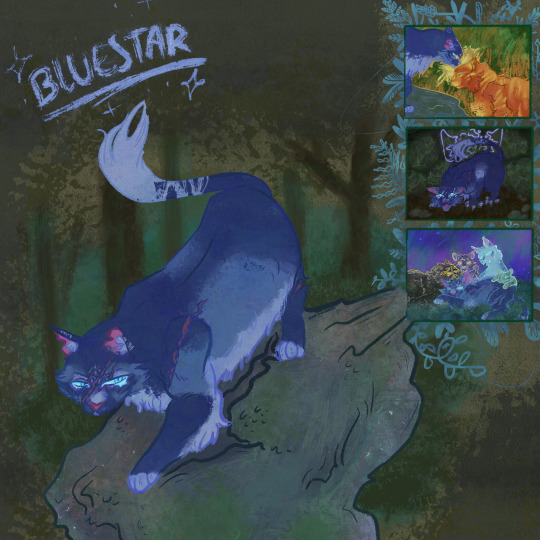#greenshipping
Explore tagged Tumblr posts
Text

i love them.
#my art#blueyellow#greenshipping#yellowblue#bluestar#yellowfang#wc#wcs#warrior cats#erin hunter warriors#warriors fanart#cat#cats#art#digital art#fanart#big fan of these guys tbh tbh#ship#lesbians
3K notes
·
View notes
Text

"yellowfang? what are you doing in bluestars den? well its none of my business" -fireheart, probably
[ID: a digital painting of Bluestar and Yellowfang, two battle-scarred gray cats, from Warrior Cats. They are cuddling in loaf positions in a den with sunlight streaming in, looking towards the entrance with slight smirks. The image is drawn in a semi-realistic art style with soft colors and shading. End ID]
#me seeing people pair bluestar and yellowfang together: Yeah ill incorporate that into my belief system#i think this totally could have happened its just that the first arc was entirely from firehearts point of view#and he doesnt know about gay people. if he did he would have realized hes bisexual and mated with graystripe#he thinks ravenpaw and barley are such good friends#warrior cats#warriors#wc#bluestar#yellowfang#yellowblue#greenshipping#bluestar x yellowfang#yellowfang x bluestar#art#2024#really though this yuri is so big brained. they both had forbidden romances and forbidden kits that were doomed#and theyre both mother figures to fireheart#and like. theyre often chilling in starclan together after they both die LOL#I just think its fascinating.
1K notes
·
View notes
Text


I hate them
#I wanted to make yellow look a lil more femme idrk why#artists on tumblr#art#my art shit#warrior cats#cats#wcue#warriors#Bluestar#YellowFang#yellowblue#greenshipping
81 notes
·
View notes
Text
one day, i will introduce the whole world to my 7-person Yu-Gi-Oh GX polycule ship.... One day....
#one day...#yugioh gx#polycule#greenshipping#idk why im so nervvy ab sharing my AUs and ships and whatnot someone gas me up so i have confidence to do it plzz#yu gi oh
2 notes
·
View notes
Text
The Future of Oil Tankers: Navigating a Sea of Change

Source: Image by HHakim
Category: Conventional Energy
Oil tankers have long been the lifeblood of the global energy market, transporting vast quantities of crude oil across oceans to fuel industries, economies, and homes. As we stand at the crossroads of a global energy transition, it’s essential to explore the future of oil tankers, which will play a pivotal role in this evolving landscape. This article delves into the trends, challenges, and innovations shaping the next chapter for oil tankers and their impact on global trade.
1. The Shift Towards Decarbonization
One of the most significant factors influencing the future of oil tankers is the global push for decarbonization. As the world grapples with the effects of climate change, there is increasing pressure on industries, including maritime transportation, to reduce greenhouse gas (GHG) emissions. The International Maritime Organization (IMO) has set ambitious targets, aiming to cut carbon emissions by 40% by 2030 and 70% by 2050 compared to 2008 levels.
To achieve these goals, oil tankers will need to undergo significant transformations. Shipbuilders are exploring alternative fuels such as LNG (liquefied natural gas), biofuels, ammonia, and hydrogen. While LNG is currently the most viable option, the adoption of hydrogen and ammonia as zero-emission fuels could radically alter the energy landscape. The future of oil tankers will likely see a blend of these fuels, helping the industry transition towards sustainability.
2. Digitalization and Smart Shipping

In tandem with decarbonization, another crucial trend shaping the future of oil tankers is the rise of digitalization and smart shipping technologies. Automation, artificial intelligence (AI), and big data analytics are revolutionizing the maritime industry, improving operational efficiency and reducing costs.
Advanced sensor technology, real-time monitoring systems, and AI-driven analytics enable ship operators to optimize routes, minimize fuel consumption, and improve safety measures. Predictive maintenance tools help detect issues before they escalate, preventing costly breakdowns. Moreover, autonomous shipping is on the horizon, with trials of remote-controlled and fully autonomous vessels underway. Though full-scale adoption may take time due to regulatory and safety concerns, the integration of such technologies will significantly alter the way oil tankers are operated.
The digitalization wave will not only increase operational efficiency but also ensure that oil tankers comply with stricter environmental regulations. These technologies can track and report emissions data in real-time, helping shipowners meet IMO requirements.
3. Geopolitical and Economic Factors

The future of oil tankers is intricately linked to geopolitical and economic factors, particularly shifts in global oil demand and supply patterns. The global energy transition towards renewable sources such as solar, wind, and nuclear energy is expected to reduce demand for crude oil in the coming decades. As more countries adopt net-zero targets and phase out fossil fuels, oil-producing nations will be forced to diversify their economies.
However, the pace of this transition will vary across regions. While Europe and North America are accelerating their shift towards renewables, demand for oil in emerging markets like India and Southeast Asia is expected to remain strong in the near term. India, for example, is projected to become the world’s largest oil consumer by 2027, overtaking China. This sustained demand in certain regions will ensure that oil tankers remain relevant for years to come, albeit at a reduced scale.
At the same time, geopolitical tensions can have a profound impact on the oil shipping industry. Trade disputes, sanctions, and conflicts in key oil-producing regions, such as the Middle East, can disrupt supply chains and alter trade routes. The ongoing shift in trade patterns, including the growing importance of Arctic routes as ice caps melt, will reshape the operational landscape for oil tankers.
4. Aging Fleet and Newbuilds
Another key element in the future of oil tankers is the composition of the global tanker fleet. As of 2024, many oil tankers in operation are aging, with an average lifespan of 20-25 years. This aging fleet is becoming less efficient, more costly to maintain, and unable to meet the stricter environmental regulations being introduced. Shipowners will face critical decisions regarding whether to retrofit older vessels with cleaner technologies or invest in new, more energy-efficient tankers.
The challenge for the industry is that new buildings, incorporating the latest green technologies, come with hefty price tags. Furthermore, with the uncertainty surrounding the future fuel landscape, some shipowners may hesitate to invest in vessels that may become obsolete within a decade. Balancing these factors will be crucial for ensuring that the oil tanker fleet of the future is both economically viable and environmentally compliant.
5. Innovations in Ship Design

The design of oil tankers is also undergoing significant changes as the industry seeks to improve fuel efficiency and reduce emissions. Hull designs are being optimized to minimize water resistance, while air lubrication systems, which reduce friction between the hull and water, are being tested. These innovations can lead to a reduction in fuel consumption by as much as 10-15%.
Wind-assisted propulsion technologies, such as Flettner rotors and kite sails, are also being explored as supplementary power sources. These technologies harness wind energy to reduce the load on the ship’s engines, thus cutting fuel usage and emissions. While these systems are still in the early stages of adoption, they hold promise for the future of oil tankers, especially for long-haul voyages.
Conclusion: The Road Ahead
The future of oil tankers is set to be defined by a complex interplay of environmental, technological, and geopolitical factors. As the global energy landscape evolves, oil tankers will need to adapt to a world that is increasingly focused on sustainability. Decarbonization efforts, coupled with advancements in digital technologies and innovative ship designs, will shape the next generation of oil tankers.
While oil demand is expected to decline over time, particularly in developed markets, emerging economies will continue to rely on crude oil for their growing energy needs. This uneven transition means that oil tankers will remain an essential part of global trade, even as the industry evolves to meet new challenges.
In conclusion, the future of oil tankers will be driven by the need to balance environmental sustainability with economic viability. Shipowners and operators must embrace innovation and remain agile in the face of changing regulations and market dynamics. Those who successfully navigate these changes will not only secure their place in the shipping industry of tomorrow but will also contribute to a more sustainable and efficient global energy system.
Found this article useful? Check out more of our posts at Oil Gas Energy Magazine!
0 notes
Text
Top 10 Trends Shaping the Future of Global Shipping in 2024

Introduction
The global shipping industry stands at the brink of transformative change as we step into 2024. With technological advancements, environmental considerations, and evolving market dynamics, the maritime sector is poised for significant developments. This article delves into the top 10 trends shaping the future of global shipping in 2024, providing insights into how these trends are set to redefine the industry.
1. Green Shipping Initiatives
Leading the Way in Sustainable Practices
The push for sustainability has never been more pronounced. Key initiatives include:
Alternative Fuels: Adoption of LNG, hydrogen, and biofuels.
Emission Reduction: Implementation of stricter IMO regulations.
Energy Efficiency: Deployment of energy-saving technologies like wind-assisted propulsion.
2. Digital Transformation
Embracing Technology for Enhanced Efficiency
Digitalization is at the forefront of shipping innovation:
Blockchain: Enhancing transparency and security in logistics.
IoT: Real-time tracking of cargo and fleet management.
AI and Big Data: Predictive analytics for optimized routing and fuel consumption.
3. Autonomous Vessels
The Rise of Self-Operating Ships
Autonomous shipping is gradually becoming a reality:
Regulatory Framework: Development of international guidelines.
Technological Advancements: Enhanced sensors and navigation systems.
Pilot Projects: Trials of autonomous vessels in controlled environments.
4. Port Infrastructure Upgrades
Modernizing for the Future
Ports worldwide are upgrading to accommodate future needs:
Smart Ports: Integration of advanced digital systems for operations.
Capacity Expansion: Building new terminals and deepening channels.
Green Ports: Investing in eco-friendly infrastructure.
5. Supply Chain Resilience
Strengthening the Backbone of Global Trade
Recent disruptions have highlighted the need for resilient supply chains:
Diversification: Sourcing from multiple suppliers to mitigate risks.
Technology Integration: Using AI and IoT for real-time supply chain visibility.
Collaborative Platforms: Enhancing coordination among stakeholders.
6. Regulatory Changes
Navigating New Maritime Laws
The regulatory landscape is evolving:
Environmental Regulations: Stricter emission and ballast water management standards.
Safety Standards: Enhanced safety protocols and training requirements.
Trade Policies: Changes in international trade agreements affecting shipping routes.
7. Cybersecurity
Protecting the Digital Seas
As shipping becomes more digital, cybersecurity is paramount:
Threat Mitigation: Implementing robust cybersecurity measures.
Awareness Training: Educating staff on cybersecurity best practices.
Incident Response: Developing comprehensive response strategies for cyber incidents.
8. Human Capital Development
Investing in the Maritime Workforce
The industry is focusing on workforce enhancement:
Training Programs: Advanced training for new technologies and safety.
Talent Acquisition: Attracting young talent to the maritime sector.
Well-being Initiatives: Improving the welfare of seafarers.
9. Global Trade Dynamics
Adapting to Market Shifts
The global trade landscape is shifting:
Trade Routes: New and emerging trade routes.
Economic Policies: Impact of global economic policies on shipping.
Market Demand: Changes in consumer demand influencing shipping patterns.
10. Environmental, Social, and Governance (ESG) Criteria
The New Standard for Shipping Companies
ESG criteria are becoming crucial:
Sustainability Reporting: Transparent reporting on environmental impact.
Social Responsibility: Enhancing social standards within the industry.
Governance: Strengthening governance practices to meet stakeholder expectations.
Conclusion
The top 10 trends shaping the future of global shipping in 2024 reflect a dynamic and evolving industry. From sustainability initiatives to technological advancements, these trends are set to redefine the maritime sector, fostering a more efficient, resilient, and environmentally conscious future.
Stay ahead in the maritime industry by keeping informed about these transformative trends. Engage with us to discuss how your organization can adapt and thrive in this evolving landscape.
Contact us for a consultation or follow our page for more insights and updates on global shipping trends.
#GlobalShipping#MaritimeInnovation#SustainableShipping#FutureOfShipping#ShippingTrends2024#DigitalTransformation#GreenShipping#MaritimeTech
0 notes
Text
PLEASE REBLOG FOR BIGGER SAMPLE SIZE !!
OKAY SO !!
a bunch of ppl are saying greenshipping/green in the tags, so when this poll close, i will reblog with another poll with the winner from this one and greenshipping ^_^
#polls#warrior cats#wc#warriors#blueyellow#bluestar x yellowfang#yellowfang#bluestar#reblog for a bigger sample size#greenshipping#green#warrior cats ships
27 notes
·
View notes
Text



glad to have each other
#warrior cats#wc fanart#waca fanart#wc bluestar#waca bluestar#wc yellowfang#waca yellowfang#wc shipping#waca shipping#wc blueyellow#bluestar x yellowfang#wc greenshipping#<- ok blueyellow community i propose we use this tag 4 them#tag/ship name#yeah#my art
3K notes
·
View notes
Text

slowly gettin the hang of procreate
shoutout to old woman yuri
#bluestar#wc bluestar#warrior cats#warriors#yellowfang#moonflower#mosskit#snowfur#firestar#fireheart#starclan#thunderclan#small art blog#old woman yuri#bluestar x yellowfang#blueyellow wc#yellowblue wc#lesbian cats#wc greenshipping#wc fanart#lesbean#wc designs#zalktis art
44 notes
·
View notes
Text

im obsessed with them btw
#morgan inventing new art style for specific drawing/characters moment number 4958639102486#blueyellow#bluestar#yellowfang#lesbians#bisexuals#personally#wc#greenshipping#fanart#warrior cats#wcs#wc fanart#warrior cats fanart#warriors fanart#erin hunter warriors#i don't think yellowfang would actually be stinky i just think she looks stinky#also sorry if ooc um. i don't care#bluestar w her paws up was necessary yknow#my art#digital art#how many tags#cat#cats#shipping#character art#artists on cara#meow#STILL GOING#sketches
87 notes
·
View notes
Video
youtube
"Revolutionizing Maritime Travel: Cutting-Edge Wind-Powered Cargo Ships ...
#youtube#WindPoweredShipping FutureOfMaritime SustainableTransport GreenShipping InnovativeSails FuelEfficiency EcoFriendlyLogistics MaritimeInnovati
0 notes
Note
People always talk about "proship" and "antiship" but never:
Redship
Brownship
Yellowship
Grayship
Greenship
Jadeship
Tealship
Ceruleanship
Blueship
Purpleship
Violetship
Pinkship
Theres a lot of different ways you can ship something! Hope this helps!
7 notes
·
View notes
Text
I love Ninjago This is no secret look at my older posts for evidence I wasn't always a Danny phantom fan
But on the topic of shipping; I'm not here to debate what ship is the best your opinion is your opinion and mine is mine I don't give a fuck about that
What I do give a fuck about is that the Ninjago fandom came up with a great system for shipping and that was to mix elements so lavashipping is Coal and Kai because fire plus rock equals lava same thing with glaciershipping plasmashipping so on so forth and I'm not even going to get into greenshipping because that's cursed as hell
Anyway my least favorite ship name and favorite ship is bruiseshipping cuz while everything else is based off element and what those elements mix and make bruiseshipping is just because of their colors or it could be because of the annoying Love rivalry with Nya included but either way it's really fucking stupid and I don't like it I don't know what to call it I just call it blackelectricshipping which doesn't really work either but it's better than bruiseshipping
Furthermore since everyone's ships minus bruise shipping is based off element ever since Nya got her water element shouldn't Jaya be called Stormshipping especially after the whole thing with seabound?
(by the way I like the color code things so that it makes sense when I'm reading it back for errors but I realize it might be confusing so here's a list of who is each color
Jay is blue
Nya is purple
Cole is orange
Kai is red
And Zane is white/black
[fully depending on what theme you have on] sorry if it's still confusing)
#ninjago#nya smith#kai smith#zane julien#cole brookstone#jay walker#ninjago nya#ninjago kai#ninjago zane#ninjago cole#ninjago jay#bruiseshipping#glaciershipping#plasmashipping#lavashipping
86 notes
·
View notes
Text
Ports Investing in Shore Power Infrastructure
Shore Power, also known as Cold Ironing or Alternative Maritime Power (AMP), is revolutionizing the maritime industry by providing ships with electrical power from the shore while they are docked. This technology allows vessels to shut down their auxiliary engines and connect to the local power grid, significantly reducing emissions of pollutants such as sulfur oxides (SOx), nitrogen oxides (NOx), and particulate matter (PM).
Shore power is particularly beneficial in reducing noise and air pollution in port cities, improving air quality, and contributing to public health. The adoption of shore power is driven by stringent environmental regulations and the maritime industry's commitment to sustainability. Ports around the world, from Los Angeles to Rotterdam, are investing in shore power infrastructure to accommodate the increasing number of vessels equipped with this capability. By enabling ships to use cleaner energy sources while docked, shore power also supports the broader transition to renewable energy and helps reduce the carbon footprint of maritime operations. The integration of shore power with smart grid technology further enhances its efficiency and reliability, making it a key component in the quest for greener, more sustainable shipping practices.
#ShorePower #ColdIroning #AlternativeMaritimePower #SustainableShipping #GreenPorts #AirQuality #PortEmissions #CleanEnergy #MaritimeInnovation #EnvironmentalRegulations #RenewableEnergy #SmartGrid #PublicHealth #NoiseReduction #CarbonFootprint #PortInfrastructure #CleanMaritimeEnergy #EmissionReduction #SustainablePorts #GreenShipping
0 notes
Text
Natadesa Resort Residence Gandeng Elite Havens untuk Layanan Properti Mewah

BALIPORTALNEWS.COM, BADUNG - Developer PT Jimbaran Hijau, pengembang Natadesa Resort Residence, secara resmi meresmikan kemitraan strategis dengan Elite Havens, pengelola properti mewah dan profesional dengan pengalaman lebih dari 20 tahun. Elite Havens telah berhasil mengelola lebih dari 300 vila pribadi yang tersebar di berbagai lokasi di Asia. Setelah mencapai keberhasilan dalam penjualan semua unit pada tahap pertama proyek Natadesa Resort Residence, PT Jimbaran Hijau bersiap memulai tahap kedua pada awal tahun 2024. Pada tahap ini, pemilik unit akan mendapatkan fasilitas yang ditingkatkan untuk mengelola propertinya melalui layanan Elite Havens.

Natadesa Resort Residence Gandeng Elite Havens untuk Layanan Properti Mewah. sumber foto : istimewa Fasilitas yang ditawarkan kepada para pemilik unit mencakup jasa pemeliharaan properti yang komprehensif, mulai dari pelayan pribadi, staf kebersihan, pengelola kebun, hingga keamanan 24/7. Selain itu, Elite Havens juga menyediakan layanan chef pribadi, pemesanan & pemasaran vila, serta pengelolaan pendapatan yang dapat diakses secara online. CEO PT Jimbaran Hijau, Dr. Putu Agung Prianta, menyatakan antusiasme terhadap kemitraan ini, dengan ekosistem yang ada saat ini, Jimbaran bukan hanya destinasi keindahan alam dan budaya di Bali, melainkan juga potensi investasi yang terpercaya. “Bersama dengan Elite Havens, para pemilik unit Natadesa dapat memaksimalkan pendapatan dan menikmati layanan berkualitas di properti mereka,”ungkap Putu Agung Prianta. Alan Porteus, Direktur Elite Havens Indonesia, menambahkan, Elite Havens berkomitmen untuk memberikan layanan terbaik kepada klien kami. Natadesa merupakan resor hunian yang luar biasa dengan potensi yang sangat besar. “Kami bangga dapat menjadi bagian dari perjalanan istimewa para pemilik Natadesa dan membantu mereka mewujudkan impian gaya hidup mewah yang nyaman dan mudah di Jimbaran Bali,”ujar Alan Porteus.

Natadesa Resort Residence Gandeng Elite Havens untuk Layanan Properti Mewah. sumber foto : istimewa Penandatanganan Memorandum of Understanding (MOU) ini menandai babak baru yang menarik bagi Natadesa Resort Residence. Kolaborasi dengan Elite Havens diharapkan tidak hanya meningkatkan pengalaman para pembeli properti di Natadesa, tetapi juga menjadikan destinasi ini semakin diminati sebagai tujuan investasi yang menjanjikan. Tentang Natadesa Resort Residence Sejak diluncurkan pertama kali pada 2021, Natadesa Resort Residence telah dikenal sebagai hunian dengan konsep pedesaan yang autentik dan alami. Merupakan salah satu perencanaan dan pembangunan yang mengedepankan sustainable development, proyek Natadesa Resort Residence sebagai hunian premium, yang dibangun di kawasan Jimbawana, Jimbaran Hijau, telah mendapatkan sertifikasi Greenship Neighborhood dengan peringkat Platinum, pertama di Bali, dengan nilai tertinggi di seluruh Indonesia. Natadesa Resort Residence, dibangun dengan design tropical modern, yang terinspirasi oleh alam dan harmoni desa Bali. Untuk pembangunan tahap kedua pada awal tahun 2024 ini, rencananya akan dibangun sejumlah 43 unit dengan 3 (tiga) type unit Villa yang namanya diambil dari nama tarian khas Daerah Bali yaitu Janger, Pendet, Legong. Natadesa Resort Residence, menjadi salah satu hunian yang premium yang berlokasi strategis, cukup 15 menit ke International Airport, 5 menit menuju ke lokasi famous seafood di Pantai Muaya, 10 menit menuju ke To Bali Mandara, dan dikelilingi berbagai fasilitas lain seperti Jimbaran Hub, Locca Seahouse, Garuda Wisnu Kencana, Udayana University, Asian Intercultural School, Bali Jimbaran & Udayana Hospital. Natadesa Resort Residence, merupakan jawaban bagi masyarakat Indonesia maupun para ekspatriat dan investor yang ingin memiliki hunian premium sekaligus investasi menjanjikan. Tentang Jimbaran Hijau Jimbaran Hijau, merupakan sebuah kawasan wisata terpadu yang telah dikembangkan sejak 2013 dengan berpedoman menjaga budaya Bali, inklusif, inovasi dan kreatif, serta keberlanjutan lingkungan agar terwujud integrasi akan kebutuhan tempat tinggal, ruang bekerja, pusat kreativitas, hiburan dan pembelajaran. Pengembangan terkini kawasan Jimbaran Hijau seperti area perumahan seperti yaitu: Natadesa Resort Residence & Damara Village. Fasilitas pendukung lainnya pun tidak ketinggalan, antara lain: Jimbaran Hub, sebagai pusat Office Space, Gallery, Wantilan Courtyard Outdoor Venue, Colabo Coworking space, tempat bermain untuk anak-anak Jungle Play, Jet Skate dan rekreasi tepi laut Locca Seahouse.(ads/bpn) Read the full article
0 notes
Text
The Sea Change: Embracing Green Energy in Cargo Shipping
Green Methanol: A Shipping Revolution? 🌿
Container shippers are ordering methanol-powered vessels to slash greenhouse gas emissions, with over 200 expected by 2028. However, challenges loom: the cost premium, limited production capacity, and the need to rapidly build global production and fuel infrastructure. Green methanol, derived from renewable sources, can reduce CO2 emissions from ships by 60% to 95% compared to conventional fuels, but it's scarce and costly. The shipping industry is navigating these hurdles on its journey to decarbonize.
WindWings: Sailing Towards Sustainability 🌬️🚢
A cargo ship embarks on a green journey with massive WindWings. These sails, like wind turbines, unfold at sea, harnessing wind power to cut fuel use and reduce the shipping industry's 2.1% global carbon footprint. This maiden voyage from China to Brazil tests the technology's potential to lower emissions by 30%. By 2025, it could reshape maritime propulsion. Wind power holds promise in reducing shipping's colossal CO2 output.
#GreenShipping #MethanolPower #WindPower #ShippingIndustry #Sustainability #ReutersAnalysis #BBCNews
#architecture#architecture history#architecture technology#architecture student#construction technology#innovation#architecture design#architecture details#architecture drawing#construction#sustainability#enviromental#climate change#climate crisis#climate emergency#climate action
0 notes